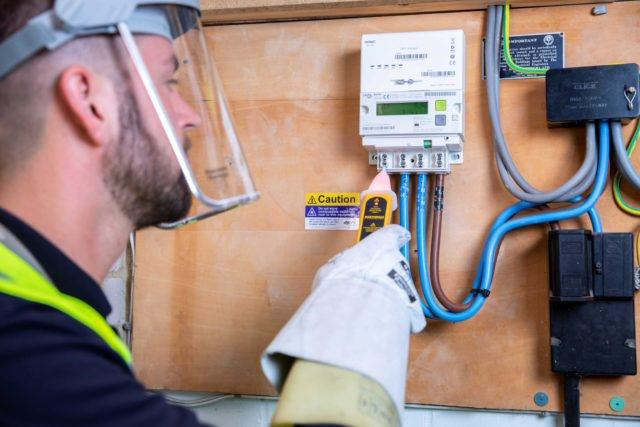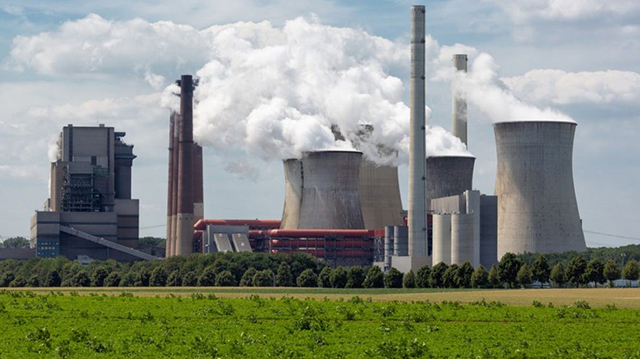
The share of renewable energy sources of Turkey's installed electricity capacity reached 45.2% in 2019, compared to 44.7% in 2018, according to the Turkish Energy Market Regulatory Authority's (EMRA) latest report on Friday.
EMRA's Electricity Market Report 2019 showed that Turkey's licensed installed capacity increased 2.1% to 84,957 megawatts last year. Natural gas got the lion’s share at 30.5%, followed by hydroelectricity with 24.3%, lignite with 11.9%, and imported coal with 10.6%.
Licensed electricity production saw a decline of 0.6% to 294,251 gigawatt-hours. Nearly 30.2% of licensed electricity production came from hydraulic plants, while imported coal, natural gas, lignite plants followed with 20.5%, 19.2% and 15.9%, respectively.
Renewable sources' share in licensed electricity production also posted a considerable increase, from 30.7% in 2018 to 42.1% in 2019.
Turkey's unlicensed installed capacity also scaled up by 18.8% to 6,309 megawatts, with 92.3% of this capacity coming from solar power plants. Unlicensed power production rose by 19.7% compared to 2018 and reached 9,829 gigawatt-hours.
Meanwhile, Turkey's electricity imports decreased by 10.3% to 2.2 terawatt-hours. Of these imports, 88.7% came from Bulgaria, 11.2% from Georgia and 0.2% from Greece.
Turkey's electricity exports also showed a 9.3% fall to 2.8 terawatt-hours. Turkey exported 95.7% to Greece and 4.3% to Bulgaria and Georgia.
Source: AA

Turkey is the second in Europe and the ninth country worldwide to have the largest installed power generated from hydroelectrical power plants (HEPP), and with newly inaugurated plants to start operating at full capacity, the country foresees reaching first place in Europe by 2023.
According to the 2020 Hydropower Status Report published by the International Hydropower Association (IHA), China is the world's largest HEPP market with an installed power of 352.260 megawatts (MW). Brazil comes second in the list with 104.139 MW, the U.S. third with 102.745 MW, Canada fourth with 81.386 MW and India fifth with 49.917 MW.
Turkey took ninth place on the list with a total of 28.358 MW installed power, followed by France with 25.519 MW. Evaluating the report, Hydroelectric Power Plants Industrial Businessmen Association (HESİAD) Chairman Taner Ercomert told Turkish daily Dunya that Turkey’s installed capacity from HEPPs would leave behind Norway – which currently has 32.256 MW – by 2023, securing the first place in Europe.
Ercomert, who is also the general manager of Limak Holding HEPP Group and a prominent name among sector representatives, said that the country’s installed capacity, which was 28.358 MW on Jan. 1, has reached to 29.193 Gigawatt electrical (GWe) as of June 1, with the new power plants entering into operation during the first five months.
“Our HEPP installed power is expected to exceed 31,000 MW at the end of the year and reach 32,000 MW in 2021,” he said, following the full capacity commissioning of recently inaugurated dams, including Ilısu, Cetin, Alpaslan 2 and Gursogut.
According to the IHA report, the world hydroelectricity installed power has increased to 1.31 million MW (1.308 GW) as of 2020. Hydroelectric power generation in the world has also broken a new record with 4,306 terawatts (TWh). The report emphasized that those figures go down in history as the highest annual electricity generation value produced based on a renewable energy source.
Highlighting the importance of renewable resources emphasized in IHA's hydroelectric status report, Ercomert said “100 million metric tons of greenhouse gas emission in the world was prevented with HEPPs replacing thermal production.”
Source: Daily Sabah

Smart meter installations in the UK dropped by 15% in the first quarter of 2020 due to the impact of the COVID-19 pandemic, according to the latest report from the Department for Business, Energy and Industrial Strategy (BEIS).
Just 980,000 smart meters were installed during the quarter, despite the first two months of the year recording higher numbers of installations than in the last quarter of 2019.
Installations fell off following the implementation of lockdown regulations on 23 March, which is also accountable for breaking the BEIS’ run of more than a million smart meters installed per quarter for the previous 12 consecutive quarters.
The BEIS figures also show a 31% decline in the installation of smart and advanced meters in smaller non-domestic sites, with just 22,000 installed over the quarter.
The report notes that the 21.5 million smart meters have been installed in the UK to date, with 17.3 million still in “smart” mode. Several million older-technology SMETS1 million meters have gone “dumb” when consumer switched suppliers, amongst other technology challenges that have plagued the rollout thus far.
The UK-wide rollout is targetted for completion before the end of 2024.
Source: Smart Energy International

Germany places a large bet on hydrogen produced using renewable energy in its highly anticipated national hydrogen strategy that serves to underpin the country's ambitions to become a global leader in the technology. The strategy puts a clear focus on this "green" variety at the expense of support for using controversial carbon capture and storage to produce hydrogen from natural gas.
While environmental activists mostly welcomed this approach, industry was critical. But many experts still agreed the strategy opened a new chapter in Germany's energy transition.
Germany’s government has agreed on a national hydrogen strategy with a controversial focus on hydrogen made with renewable energies to boost its landmark energy transition and conquer future markets for its famed industry. Following months of delays, the highly anticipated strategy was approved by ministers on 10 June. The paper says "only hydrogen produced on the basis of renewable energies ('green' hydrogen) is sustainable in the long term."
Hydrogen made with natural gas using carbon capture and storage which is highly controversial in Germany, is only to be used "on a transitional basis."
In the fight against climate change, hydrogen made with renewable electricity is increasingly seen as a silver bullet for sectors with particularly stubborn emissions, such as heavy industry and aviation. Germany, which has set itself the target of becoming climate neutral by mid-century, has set out to become a global leader in the associated hydrogen technologies - not only to launch the next stages of its landmark energy transition, but also to secure a promising growth market for its internationally reputed industry.
The strategy is a "quantum leap" that will lift the energy transition and climate protection to a "new qualitative level," according to the country's economy and energy minister Peter Altmaier. During a press conference marking the launch of the strategy, he called the initiative the "most important innovation since our decision to support the roll-out of renewables."
Research minister Anja Karliczek said the whole world was waking up to the opportunities presented by green hydrogen technologies. "Building a global hydrogen economy offers enormous potential for German plant manufacturers," Karliczek said. Environment minister Svenja Schulze said hydrogen is the "energy of the future" that will give a "double boost" to the climate and jobs. "Above all, we will sell the technology – we're really good at that in Germany," Schulze told public broadcaster ARD.
Source: Clean Energy Wire

In the wake of the COVID-19, electricity demand in Japan has dropped and power prices have declined. The electricity sector is further impacted by ongoing economic contraction, delays in the shipment of photovoltaic (PV) modules from China, and low nuclear availability.
These factors are leading to the use of coal and gas to support the baseload power requirement in Japan, says data and analytics company GlobalData. Solar is the major driving force for renewable deployment in the country. Before the COVID-19 outbreak, revisions in the tariff structure and grid interconnection issues were likely to slow down deployment. Amid these tumultuous times, the country witnessed a halt in construction activity, which is expected to further delay the installation of fresh capacities.
With hiccups on the solar front, coal is expected to continue to play an integral role in the country’s power sector. Despite the low power demand, the abnormal weather conditions and low availability of nuclear facilities are expected to support the high consumption of coal for electricity generation. In the first three months of 2020, Japan imported 44.8 million tons of coal, which increased by 3.4% in comparison to 43.3 million tons imported in the first quarter of 2019.
Somik Das, Senior Power Analyst at GlobalData, comments: “Japan, in its quest to meet the target of having 24% of its energy use from renewables by 2030, made investments in the solar and offshore wind a priority. However, these efforts are expected to experience a set back due to the COVID-19 outbreak. As China forms an integral part of the solar supply chain, the onset of the pandemic has affected the shipment of photovoltaic modules and other equipment for many Japanese developers.
“As per the last amendments to Renewable Energy Act, solar projects have to meet strict deadlines to reach commercial operation, the government has released aid to help the projects bound by power purchase agreements (PPAs). In the $1.1tn stimulus package, the government has made provisions of $1bn for the development of onsite renewables which are expected to support corporate power purchase agreements under their commitment to the RE100 initiative.”
Source: Power Enginering International

The failure of governments and central banks to set out a green recovery from the coronavirus crisis is threatening to derail vital UN climate talks aimed at staving off global catastrophe, campaigners have warned.
On Friday, the UK and the UN attempted to revive the stalled COP26 climate talks, with a coalition of businesses committing to a Race for Zero, signing up to reduce their emissions to net zero by mid-century. Close to 1,000 businesses have joined the campaign, including household names such as Rolls-Royce and the food and drink majors Nestlé and Diageo.
Mark Carney, former governor of the Bank of England and UN special envoy for climate and finance, said: “The transition to net zero is creating the greatest commercial opportunity of our time. Net zero targets must be underpinned by transition plans so that investors can assess which companies will seize the opportunities in the transition and which will cease to exist.”
But rhetoric is not enough while central banks are still pouring money into propping up “business as usual”, according to campaigners.
“It’s been great to hear the government’s warm words about the green recovery, but what really matters now are the policies and investments needed to make it a reality,” said Morten Thaysen, green recovery campaigner at Greenpeace UK.
“The UK has a chance to lead on the world stage next year with COP26, and set an example of what building back better actually looks like. Committing to this ahead of the climate talks will show international leadership on what a truly green recovery looks like.”
The vast majority of the stimulus money so far announced by governments around the world is set to prop up the fossil fuel economy, according to analyst company Bloomberg New Energy Finance. More than half a trillion dollars worldwide – $509bn – is to be poured into high-carbon industries, with no conditions to ensure they reduce their carbon output.
Only about $12.3bn is to go towards low-carbon industries, such as renewable energy, and a further $18.5bn into high-carbon industries provided they achieve climate targets.
Source: Euractiv
Renewables Continue to Break Records Despite COVID-19
Despite the devastating impact of COVID-19, during the months of April and May, renewable energy continued to break records, according to the Institute for Energy Economics and Financial Analysis (IEEFA).
Please click here to read the full report.

